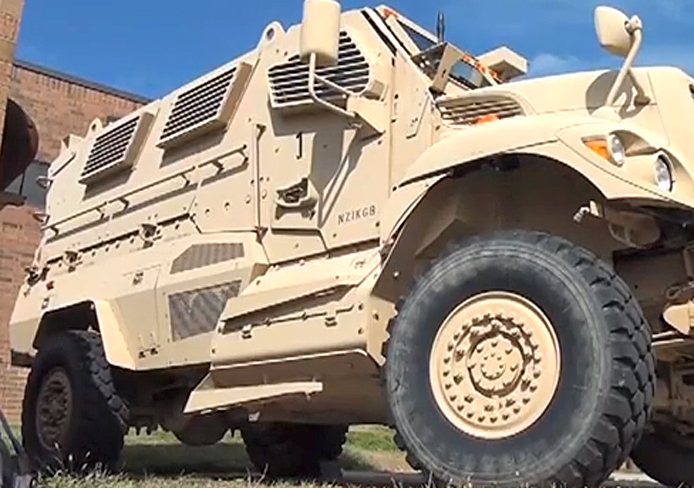
The University Department of Public Safety acquired a Mine Resistant Ambush Protected vehicle in early September.
Credit: Alice Bacani / BuckeyeTV asst. news director
The Ohio State University Police Division has acquired a vehicle fit for war.
The Mine Resistant Ambush Protected Vehicle was donated earlier this month. Similar vehicles have been used in United States military conflicts in countries including Iraq and Afghanistan.
The vehicle comes suited with a turret designed for mounting an automatic firearm, armored siding, bulletproof glass and a frame high enough to allow it to travel through three feet of water.
The MRAP vehicle is meant to be used mainly for large-scale emergency situations, according to University Police officers, but some OSU students don’t think the vehicle is necessary.
University Police Chief Paul Denton said the vehicle was acquired at no cost to the university from a military surplus program in order to replace a similar vehicle owned by the department that was outdated. The previous vehicle saw little use, but had similar purposes to those of the new vehicle, Denton said.
The new vehicle was acquired to serve for the potential purposes of officer rescue, hostage situations, bomb threats, homeland security and active shooter scenarios, Denton said.
Kyle Smith, Staff Sgt. in the U.S. Air Force Reserves and a fourth-year in criminal justice, said he doesn’t see a need for University Police to have a military vehicle that can withstand the blast of a 500-pound bomb, but he understands the logic behind why the department acquired one.
“It makes sense,” Smith said. “Why pay $300,000 for an armored (Chevrolet) Suburban when you can get a much more useful vehicle for free?”
OSU often borrows vehicles of similar quality to serve previously listed purposes during large events like football gamedays, Denton said.
It will serve primarily as a mode of transportation and protection for University Police, Denton said. He added the vehicle will be used if a situation arises but will primarily be used in instances where University Police has a strong presence, such as gamedays, Denton said.
University officers will be trained to use the vehicle by volunteers from military programs similar to the one that provided the vehicle to University Police, Denton said.
“I’m not seeing any cons considering we didn’t have to pay for it,” said Juliana Wishne, a second-year in political science and Spanish.
Not all students are fond of the university’s new acquisition, however. Terry Pack, a fourth-year in economics, is concerned any sort of militarization of the police force implies students are not well-protected.
“This thing is really cool and I want to drive it, but giving campus police the authority to operate a vehicle designed for war is incredibly intimidating and suggests the current (methods are) incapable of doing (their) job to adequately serve and protect,” Pack said.
To lessen intimidation brought about by the presence of this vehicle, OSU will be painting it black and removing the turret from its top. Though the cost of those changes has not been estimated yet, Denton said the money will come from the University Police budget.


